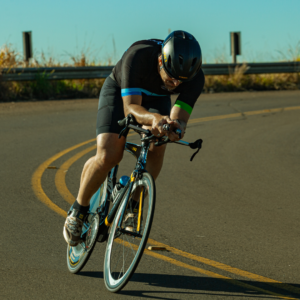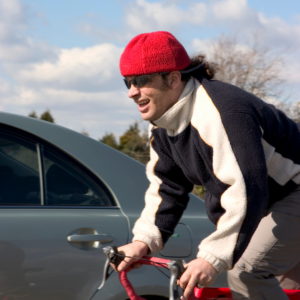Riding a bike in Washington, DC is a popular way to get around and is encouraged by organizations like Washington Area Bicyclist Association (WABA), but it’s important to know the rules of the road. Washington, DC has specific traffic laws for bicyclists designed to keep everyone—cyclists, drivers, and pedestrians—safe.
Whether you’re traveling to work or just going for a relaxed bike ride, knowing these rules can help avoid accidents and keep you following the laws of our nation’s capital.
Injured in a bike accident? Contact our experienced DC bicycle accident attorneys today for a free consultation. We’ll fight for your rights and fair compensation.
Contact Us Today to Schedule
a Free Consultation

Just like motorists, bike riders must obey traffic signals, signs, and lane markings. That means stopping at red lights and stop signs, yielding to pedestrians, and signaling turns. Using hand signals is the key way to let drivers and other cyclists know where you’re headed. When turning, be sure to look both ways, signal, and move only when it’s safe to do so.
Drinking and biking might seem harmless to some, but in Washington, DC, it’s illegal to ride a bicycle while under the influence of alcohol or drugs. This is because impaired cyclists can be just as dangerous as impaired motor vehicle drivers. When you’re under the influence, your reaction times are slower, your balance is off, and your judgment is impaired, all of which can lead to serious accidents.
If you’re caught riding a bike while intoxicated, you could face legal consequences similar to those for driving under the influence (DUI). It should go without saying that it’s always a better idea to take public transportation or use a rideshare service if you’ve had too much to drink.

It’s also important to note that lane splitting is only allowed when overtaking vehicles, not just for cruising alongside traffic. If you’re not passing cars, it’s best to stay in your lane or in designated bicycle lanes for safety.
Many people have questions about what’s legal and what’s not when riding a bike in DC. Let’s answer some of the most frequently asked questions.
Washington, DC bike laws require cyclists under the age of 16 to wear a helmet, but protective bicycle helmets are not mandatory for adults. However, wearing a protective helmet is always a good idea for safety, as helmets significantly reduce the risk of head injuries in accidents. Even if the law doesn’t require it, wearing one could protect you in case of a bicycle crash.
Cyclists are required to stop at stop signs, just like drivers. While it might be tempting to roll through when there’s no traffic in sight, it’s important to remember that stop signs are there for a reason—keeping everyone on the road safe. Not only can running a stop sign result in a fine, but it also increases the risk of a collision. Taking those extra few seconds to come to a complete stop gives you a chance to make sure it’s safe to proceed. It might seem like an inconvenience, but following the rules can go a long way in preventing accidents.
In DC, pedestrians have the right-of-way in crosswalks. If you’re cycling and see someone walking at a crossing, it’s your duty to stop and allow them to cross. It’s not just about stopping but also about giving them enough space and time to cross safely. Remember, even if you’re on a bike, you can’t just go through the crossing without stopping. Failing to yield can result in fines or a collision.
No, cyclists in DC are not required to ride in a bike lane. While bike lanes are designed to give cyclists a safer space on the road, sometimes they’re not available, or a cyclist may need to use the main road to avoid obstacles. People on bikes are allowed to ride in regular traffic lanes, but they should stay as far to the right as is safe unless they’re making a left turn or avoiding hazards.
In some parts of DC, the use of bicycles on the sidewalk is legal, but there are restrictions. According to the District Department of Transportation (DDOT), cyclists can ride on all streets and sidewalks outside the DC Central Business District, which is roughly the area between the National Mall and Massachusetts Avenue. Outside of that area, sidewalk riding is permitted, but cyclists must yield to pedestrians and ride slowly.
Yes, DC law requires that bicycles have front and rear lights when riding at night or during low-visibility conditions, like fog or rain. On a bike at night, the front light should be a white light, and the rear light should be red. These reflector lights make cyclists more visible to drivers and other road users, helping prevent accidents.
Using lights significantly reduces the risk of accidents, as it increases your visibility to everyone on the road. Even if you’re riding in a well-lit city environment, streetlights alone aren’t enough to make you stand out. Proper lighting on your bike ensures that other road users are aware of you, giving everyone more time to react and keeping the streets safer.
In Washington, DC, no more than two cyclists can ride side by side in a traffic lane. Riding more than two abreast can make it harder for drivers of motor vehicles to pass safely. When cycling in groups, it’s best to stick to two bicycle riders side by side, and if traffic is heavy or space is tight, it’s a good idea to ride single file.

For example, if you were riding against traffic or didn’t stop at a stop sign and got hit by a car, the driver’s insurance company might argue that your infraction contributed to the accident. This can make it much harder to get financial compensation for medical bills, lost wages, or bike repairs. That’s why it’s important to follow all traffic laws when biking.
If you’re in an accident, a skilled bike accident lawyer can help you understand the legal system and determine whether you’re entitled to compensation. Even if you think you may be partially at fault, an experienced attorney can still provide valuable guidance.
If you’ve been injured in a bicycle accident in Washington, DC, it’s essential to have an experienced legal team on your side. At Regan Zambri Long, our personal injury lawyers understand the challenges bicycle operators face and are here to help you recover after an accident. Whether you’re dealing with medical bills, lost wages, or pain and suffering, we’ll fight to get you the fair compensation you deserve.
Our bike accident team has decades of legal experience handling bicycle accident claims and a deep understanding of DC traffic laws. Our record of success underscores our commitment to protecting the rights of injured cyclists, and we will work tirelessly to hold negligent drivers accountable. Don’t wait—contact Regan Zambri Long today to discuss your case. You deserve an attorney who will listen to your story, explain your options, and stand up for your rights.
Understanding traffic laws is part of staying safe while biking in DC. But accidents happen, and when they do, having a knowledgeable lawyer on your side can make all the difference. Reach out to Regan Zambri Long for a free consultation to get the help you need and the justice you deserve.